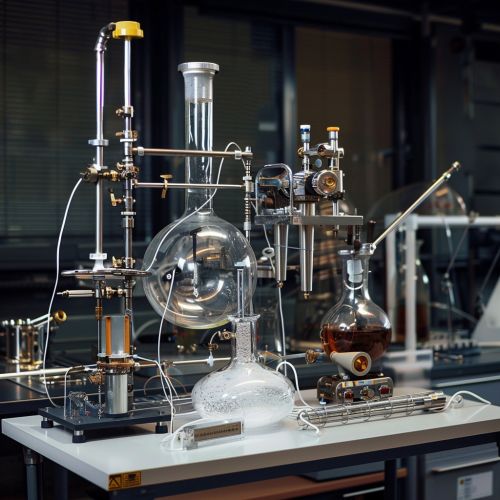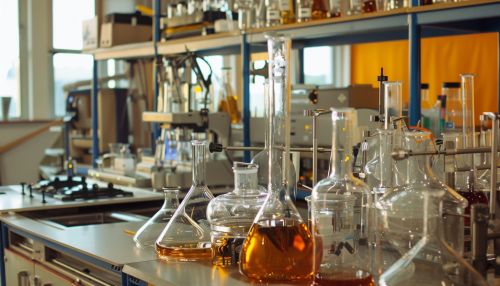Equation of state
Introduction
An equation of state (EOS) is a mathematical model that describes the relationship between various state variables such as temperature, pressure, volume, and internal energy of a given system. These equations are pivotal in the fields of thermodynamics, physical chemistry, and material science, as they provide critical insights into the behavior of substances under varying conditions.
Historical Background
The concept of an equation of state has evolved significantly over time. Early attempts to describe the behavior of gases led to the development of the Ideal Gas Law, formulated by Robert Boyle and Jacques Charles. However, real gases exhibit deviations from ideal behavior, prompting the development of more sophisticated models such as the Van der Waals equation and the Redlich-Kwong equation.
Types of Equations of State
Equations of state can be broadly categorized into several types based on the nature of the substances they describe and the complexity of the models.
Ideal Gas Law
The Ideal Gas Law is the simplest form of an EOS and is given by: \[ PV = nRT \] where \( P \) is the pressure, \( V \) is the volume, \( n \) is the number of moles, \( R \) is the universal gas constant, and \( T \) is the temperature. This equation assumes no interactions between gas molecules and is applicable only under low-pressure and high-temperature conditions.
Van der Waals Equation
The Van der Waals equation introduces corrections for molecular size and intermolecular forces: \[ \left( P + \frac{a}{V^2} \right) (V - b) = nRT \] where \( a \) and \( b \) are empirical constants specific to each gas. This equation provides a more accurate description of real gases compared to the Ideal Gas Law.
Redlich-Kwong Equation
The Redlich-Kwong equation is another refinement of the Ideal Gas Law, expressed as: \[ P = \frac{RT}{V - b} - \frac{a}{\sqrt{T} V (V + b)} \] This equation is particularly useful for describing the behavior of gases at intermediate pressures and temperatures.
Peng-Robinson Equation
The Peng-Robinson equation is widely used in the petroleum industry for its accuracy in predicting the behavior of hydrocarbons: \[ P = \frac{RT}{V - b} - \frac{a(T)}{V (V + b) + b(V - b)} \] where \( a(T) \) is a temperature-dependent function. This equation provides reliable results for both liquid and vapor phases.
Cubic Equations of State
Cubic equations of state, such as the Soave-Redlich-Kwong (SRK) and Peng-Robinson (PR) equations, are commonly used in engineering applications. These equations are called "cubic" because they can be expressed as cubic polynomials in terms of volume.
Applications
Equations of state are essential tools in various scientific and engineering disciplines. They are used to design and optimize processes in chemical engineering, predict the behavior of materials under extreme conditions in material science, and understand the thermodynamic properties of fluids in physical chemistry.
Chemical Engineering
In chemical engineering, EOS models are used to design reactors, distillation columns, and other process equipment. Accurate EOS models enable engineers to predict phase equilibria, calculate heat and work requirements, and optimize process conditions.
Material Science
Material scientists use EOS models to study the behavior of materials under high pressure and temperature conditions. These models help in understanding phase transitions, mechanical properties, and the stability of materials.
Physical Chemistry
In physical chemistry, EOS models are used to study the thermodynamic properties of gases, liquids, and solids. They provide insights into molecular interactions, phase behavior, and the energetics of chemical reactions.
Advanced Models
While the aforementioned equations of state provide valuable insights, more advanced models have been developed to address specific challenges and improve accuracy.
Statistical Mechanics
Statistical mechanics provides a framework for deriving equations of state from first principles. The Boltzmann equation and the Gibbs free energy are fundamental concepts in this approach. These models consider the microscopic behavior of particles and their interactions to predict macroscopic properties.
Molecular Dynamics
Molecular dynamics simulations use computational methods to model the behavior of molecules over time. These simulations provide detailed information about molecular interactions and can be used to develop more accurate EOS models.
Quantum Mechanics
Quantum mechanical methods, such as Density Functional Theory (DFT), are used to study the electronic structure of materials. These methods provide insights into the behavior of materials at the atomic level and can be used to develop EOS models for complex systems.
Challenges and Limitations
Despite their utility, equations of state have limitations and challenges that must be addressed.
Accuracy
The accuracy of an EOS model depends on the quality of the empirical data and the assumptions made in the model. Deviations from ideal behavior, such as non-ideal mixing and phase transitions, can introduce errors.
Applicability
Different EOS models are applicable under different conditions. For example, the Ideal Gas Law is only accurate at low pressures and high temperatures, while the Van der Waals equation is more suitable for real gases. Selecting the appropriate EOS model for a given application is crucial for accurate predictions.
Computational Complexity
Advanced EOS models, such as those derived from statistical mechanics or quantum mechanics, can be computationally intensive. These models require significant computational resources and expertise to implement.
Future Directions
Research in the field of equations of state continues to evolve, with ongoing efforts to develop more accurate and versatile models.
Machine Learning
Machine learning techniques are being explored to develop data-driven EOS models. These models can leverage large datasets to improve accuracy and predict the behavior of complex systems.
Multiscale Modeling
Multiscale modeling approaches aim to bridge the gap between microscopic and macroscopic descriptions. By integrating information from different scales, these models can provide more comprehensive and accurate predictions.
Experimental Techniques
Advances in experimental techniques, such as high-pressure and high-temperature measurements, are providing new data to refine and validate EOS models. These techniques enable the study of materials under extreme conditions and contribute to the development of more accurate models.
Conclusion
Equations of state are fundamental tools in the study of thermodynamics, physical chemistry, and material science. They provide critical insights into the behavior of substances under varying conditions and are essential for designing and optimizing processes in various scientific and engineering disciplines. Ongoing research and advancements in computational methods, experimental techniques, and data-driven approaches continue to enhance the accuracy and applicability of EOS models.
See Also
Categories


